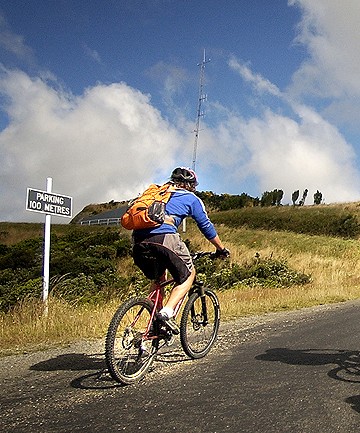
The economic benefits of environmentally smart cycle tourism can drive a recovery in provincial New Zealand and have the potential to double the amount tourists spend annually – from $320 million to $640 million, tourism leaders say.
At the Ecotourism 2010 conference in Rotorua this month, cycle tourism leaders explained the power of pedallers and applauded the injection of $9 million of the prime minister's $50m cycleway fund into "quick start" ventures that will see new multi-day routes operating this summer.
"Cycle tourism is about economic development," says Richard Balm, project manager on Nga Haerenga, the New Zealand Cycle Trail initiative. "It's is a really simple and environmentally sound method of taking money into local economies and feeding economic recovery."
Nga Haerenga was inspired by the success of New Zealand bike trails such as the Otago Central Rail Trail and international cycling routes, such as Canada's Route Verte.
The Route Verte in Quebec, completed in 2007, is a 4000-kilometre network of cycle paths which not only helped to attract visitors but was promoted as a healthy outdoor recreational pursuit for locals.
It is now regarded as among the 10 best bicycle routes by the National Geographic Society.
Halfway through the three-year government allocation of $50m, 13 new projects have been added to network, Mr Balm says.
The Government confirmed $18.85m in July for the construction of eight trails. These trails, together with five trails already approved, are expected to provide 1700km of trails once completed. They include $3.4m for the Waikato River Trail, $2.6m for trails in Nelson-Tasman, $2.5 for the Clutha Gold Trail in Otago, and about $2m for trails in Queenstown, Opotiki and Hawke's Bay.
Regional cycling tracks and trails dubbed the Great Rides will ultimately unite to form a national cycle network.
Mr Balm says the latest funding reflects the research undertaken when Prime Minister John Key set up the $50m cycleway fund. "What we discovered immediately was that there was no sense in building a cycle track from the top of the country to the bottom.
"The value lay in building two to four-day rides in rural and provincial areas that slow visitors down and feed their money into accommodation and support businesses – cafes, markets, art and craft businesses, museums and so on. Really, in terms of economic investment in provincial areas, it's a no-brainer for the Government: the $50m they've committed is equivalent to about half a highway, and the long-term returns are immeasurable."
The recovery of the Central Otago communities that support the Otago rail trail is the much-quoted showcase for how tourists on bikes can reinvigorate regions, especially those with heritage, areas of natural beauty or indigenous cultural value.
The Otago Central Rail Trail is a 150km cycleway that follows the path of the former railway. The trail goes from Middlemarch to Clyde in Central Otago and is a living history of farming communities and goldmining in New Zealand.
Developed by the Conservation Department in conjunction with the OCRT Trust, the project picked up an international conservation award this month at the Parks Forum in Sydney.
The Parks Forum is an international body for park management organisations in New Zealand, Britain and Australia. The award recognises the economic and environmental benefits of conservation projects for the local community.
The Otago rail trail was built for walkers, cyclists and horse riders. More than 60 of the original bridges along the old railway have been restored, and the trail has become New Zealand's most popular cycleway.
The rail trail attracts between 10,000 and 12,000 tourists every year, and up to 80,000 people are thought to use some part of it regularly. A recent economic study showed that nearly half the businesses along the rail trail gained 20 per cent of their revenue from tourists using the trail.
DOC's general manager of research and development, Kevin O'Connor, who also addressed the Rotorua ecotourism conference, says the Otago rail trail shows the value that positive partnerships with local businesses bring to conservation projects.
"It's a great example of how investing in conservation programmes results in a real economic spin-off for the whole community," he said. "By stepping out with the community, we've helped turn a disused rail line into a popular bike trail – we've conserved a community asset and also added real economic value to many local businesses and communities."
From stuff.co.nz
